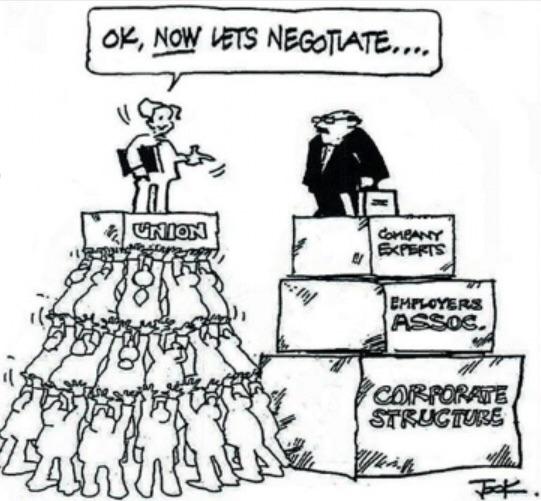Negotiations History
Understanding Negotiations
LAST UPDATED FEBRUARY 2024
Where We're At in the Process: Mediation
On January 18, 2024 APFA National President Julie Hedrick submitted a request to the National Mediation Board (NMB) stating that contract negotiations are at an impasse and Flight Attendants should be free to strike American Airlines. The letter requested a meeting with NMB members to advance our case that negotiations are deadlocked, and that they should issue a proffer of arbitration/release to strike. On March 13, 2024, the NMB status conference was held. You can read more about it here.
Mediation is scheduled for April 9-11 & April 30-May 2.
Under the Railway Labor Act, we cannot strike until we have been released by the National Mediation Board (NMB) and following a thirty-day cooling-off period. Typically, the NMB wants the remaining issues to be sufficiently narrow to resolve during the thirty-day cooling-off period. They also want to be clear that the negotiations are at an impasse or stalemated. That means that we have pursued all avenues for an agreement. Unions may request release, but the decision to grant the release is exclusively up to the NMB and is based on their analysis of the negotiations.
Related Hotlines:
3.19.24 - Negotiations Update #51: Mediated Negotiations Continue
3.15.24 - Negotiations Update #50: National Mediation Board Status Conference Update
1.25.24 – Negotiations Update #48: NMB Status Conference
1.19.24 – Negotiations Update #47: Mediation Release Request
11.28.23 – Negotiations Update #42: NMB Denies Request for Release
11.20.23 – Negotiations Update #40: Mediation Release Request, Next Steps and Frequently Asked Questions

Negotiations Process Update Videos
Strike Authorization Vote Recommendation

Why Do Negotiations Take So Long?

Federal Mediation Begins

The Importance of Being Dues Current

Securing the Contract We Have Earned

Negotiations Today:
How It Works
Negotiations in the airline industry are governed by the Railway Labor Act (RLA), a federal law passed by Congress in 1926, then amended in 1936 to include Airlines. The guiding principle of this law is to protect the flow of interstate commerce. The rules of negotiations applied to these two industries are very different from the rules of negotiations in almost every other industry. The two primary differences are that contracts do not expire, they become amendable and there is no set timeframe for a new contract to be achieved.
It is important to understand the differences in the process for the previous negotiations and the current one. Our JCBA was negotiated under terms agreed to by APFA and US Airways management in the event US Airways was successful in fulfilling the merger with American Airlines. The terms were spelled out in the Conditional Labor Agreement (CLA), also referred to as the Bridge Agreement.
Under the terms of the CLA, APFA agreed to a 60-day period of negotiations to come to agreement on a new contract for the combined carriers. If no agreement was reached in the 60 days, then the parties would submit the remaining issues to binding arbitration. In order to achieve this very tight timeline, the parties agreed to adopt whole sections wherever possible from the existing APFA contract with American and the existing AFA contract with US Airways. This is not the normal process of negotiations under the Railway Labor Act (RLA).
The normal process of negotiation contains four phases: Direct Negotiations, Mediated Negotiations, Super-mediation during the 30-day cooling off period and, finally, being Released into self-help. Under the RLA, the only phase of negotiations that has a specified time period is the 30-day cooling off period. That means there is no deadline for reaching agreement on a new contract. Traditional negotiations can, and usually do, take a very long time, usually measured in years.
The current negotiations are being conducted under the traditional process and we are currently in the first phase, Direct Negotiations between APFA and management. APFA is taking strategic actions to try to achieve a new contract expeditiously while still achieving your priorities.
The first unions formed in the US over 200 years ago. Workers recognized they had more power collectively than they had individually when it came to securing improvements in wages and working conditions.

Videos
This video explains the Railway Labor Act as well as the process of Section 6 negotiations. Please take a few minutes to watch it and share it with our fellow crewmembers.
The more we learn about the process, the more prepared we will be to engage in ACTION events designed to support our contract negotiations.
Negotiations Town Hall Videos
Negotiations: Terminology Explained
Knowledge is Power
Contract / Collective Bargaining Agreement (CBA) - These terms are used interchangeably for the document that contains all the negotiated rules and provisions under which we work.
Joint Collective Bargaining Agreement (JCBA) - This term is applied to the contract under which we are currently working. It is called this because it is the product of joining the Legacy American Airlines contract and the Legacy US Airways contract into a single (joint) contract as part of the merger of the two companies. View the Current JCBA
Railway Labor Act (RLA) - The federal law the governs contract negotiations in the airline and rail industries.
Section 6 - This reference is to the specific section of the Railway Labor Act that governs the process of negotiations in the airline and rail industries.
Deadlocked - Sections with this designator indicate both parties feel like they have made all the movement they can make in the section but still have not managed to come to an agreement. Eventually, these sections will have to be resolved in order for there to be a new contract/CBA.
Current Book - This designator indicates that the parties have agreed the language in the current contract will continue to be sufficient for the new contract. This may be the outcome even though one or both parties may have initially proposed changes in the section or it may be the outcome because neither party proposed any changes to the section.
Ratification - This is the process of the members of APFA voting on whether or not to approve the new contract. After all sections/provisions of the contract have been tentatively agreed upon by the company and APFA, the final product is then submitted to the membership for a ratification vote. If the agreement is ratified (approved) by a majority of the members, it becomes the new contract. What happens if it is rejected by a majority of the members depends on what stage of the Railway Labor Act process we are in at the time.
Direct Negotiations - The initial phase of negotiations where the union and the company are passing proposals for a new contract.
Mediated Negotiations - Typically the second phase. If the parties are unable to reach agreement on a new contract in direct negotiations, either party or both may request the assistance of a mediator from the National Mediation Board (NMB). The mediator will then spend the next phase of negotiations trying to help the parties reach an agreement.
30-Day Cooling Off Period/Super-mediation - The third phase of the negotiations process. This phase is only reached if the mediated negotiations fail to produce agreement on a new contract. The NMB will then set a 30-day cooling off period. During the 30-day cooling off period, the NMB will make one final attempt to help the parties reach agreement in what is called Super-mediation.
Release into Self-help - The final step of the negotiations process under the RLA. If Super-mediation fails to produce a new agreement, then the NMB releases the parties from the process into self-help. Self-help for the union can include a strike or other measures to put pressure on the company. For the company, it can include locking out the union employees or other measures to pressure on the union to agree to a new contract.


